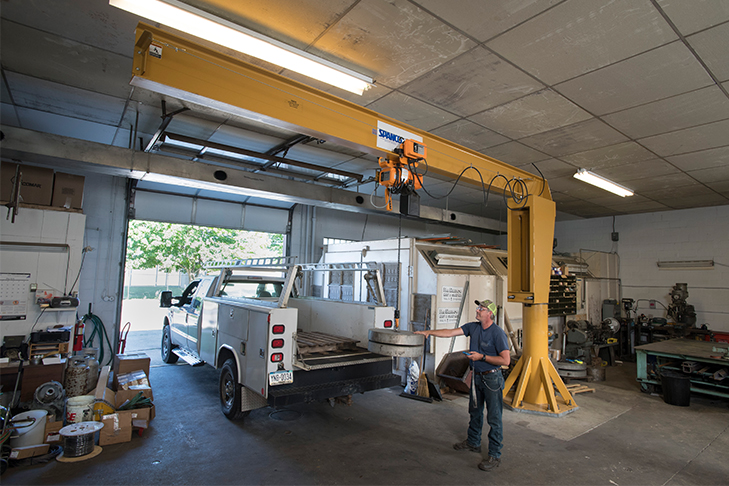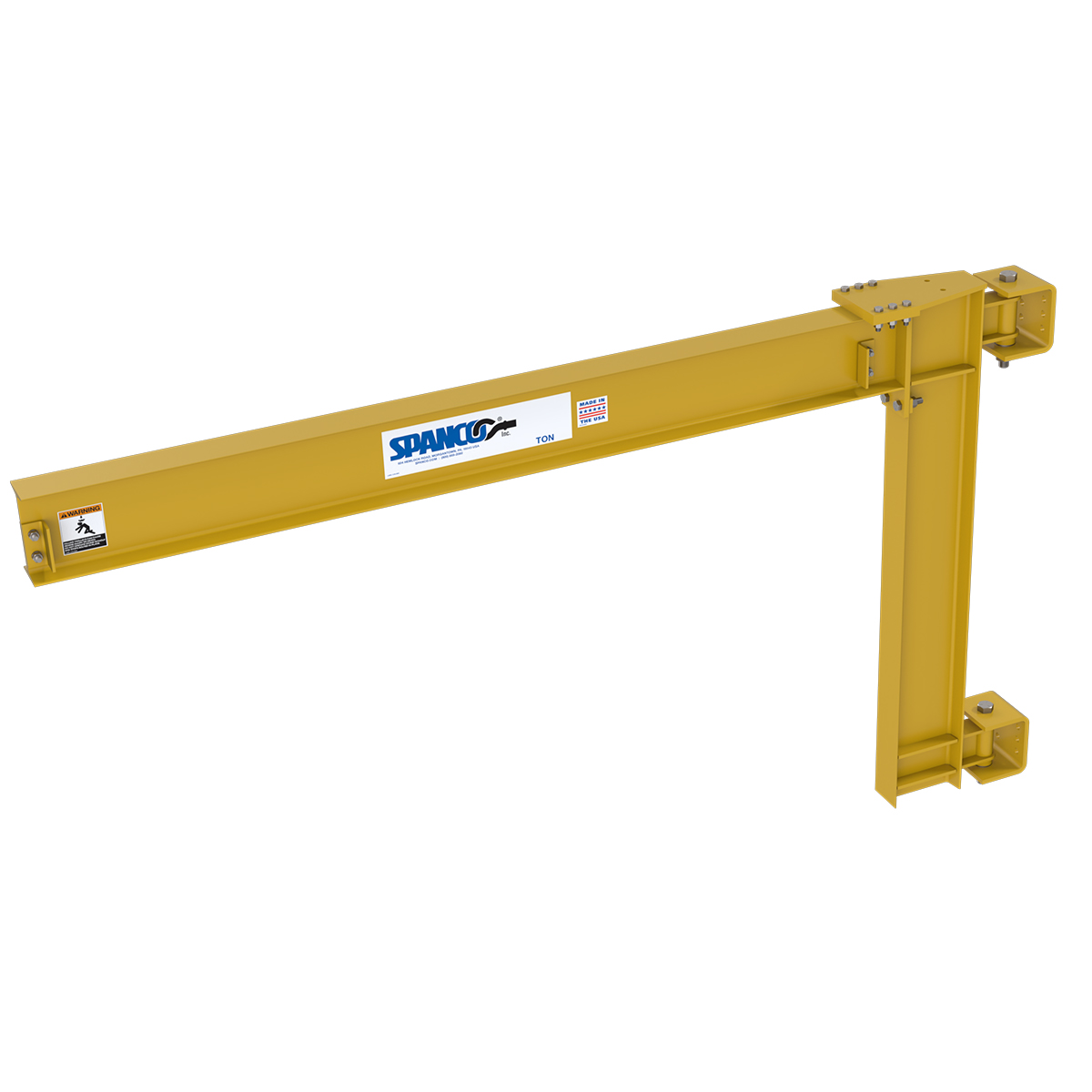Foundationless Jib Cranes – 600 Series
- Crane Rotation: 360°
- Spans: 8′ – 20′
- Capacities: up to 2,000 lbs.
- Heights—floor to underside of boom: 8′ – 20’
Spanco Foundationless Jib Cranes are industrial slab-mounted systems that are bolted to reinforced concrete. These systems do not require a special foundation to be poured, so they can be installed almost anywhere within your facility and be easily relocated if needed.

Options & Components
Additional Information
Spanco Foundationless Jib Cranes are industrial slab-mounted systems that are bolted to reinforced concrete. These systems do not require a special foundation, which can sometimes cost more than the system. By not requiring a special foundation, you don’t have to wait for concrete to cure, meaning you can have your system installed sooner. Spanco Foundationless Jibs can be installed almost anywhere within your facility and be easily relocated if needed.
| Capacities (Pounds) | HUB (Feet) | Span (Feet) |
| 500 | 8-20 | 8-13* |
| 1,000 | 10-20 | 8-9* |
*Varies depending on HUB selected
Features of Spanco 600 Series Foundationless Jib Cranes
- 360-degree rotation
- Base plate is secured by chemical anchor bolts to a prescribed reinforced concrete foundation
- The pipe mast’s connection to the hexagonal base plate is reinforced with six equally-spaced gussets
Spanco, Inc. warrants its products to be free from defects in material and workmanship as follows:
- Manual Systems & Equipment: Ten Years
- Motorized Systems & Equipment: One Year
- Paint & Finishes for Non-Aluminum Components: Two Years
Ten-Year Warranty Coverage:
- Defects in equipment material and workmanship of manual systems and equipment
- Wearable parts (workstation bridge crane end trucks and hoist trolley wheels only)
Spanco, Inc. warrants its manual workstation bridge crane, jib crane, and gantry crane products to be free from defects in material and workmanship for a period of ten (10) years or 20,000 hours, commencing on the date of shipment to the first retail purchaser. This warranty extends to non-wearable parts only, with the exception of the wheels supplied on manually operated workstation end trucks and hoist trolleys.
One-Year Warranty Coverage:
- Defects in equipment material and workmanship of motorized systems and equipment
Spanco, Inc. warrants motorized equipment to be free from defects in material and workmanship for a period of one (1) year or 2,000 hours, commencing on the date of shipment to the first retail purchaser.
Two-Year Warranty Coverage:
- Paint coatings and finishes for non-aluminum components
Spanco, Inc. warrants its paint and finishes for a period of two (2) years. Warranty claims related to coatings must be accompanied by documentation of the product’s application and environmental conditions from time of delivery to time of claim.
WARRANTY TERMS & CONDITIONS
All warranty claims must be approved by Spanco before any work is performed. Spanco’s obligation under this warranty is limited to the replacement or repair of Spanco products at the factory or separate location approved by Spanco. Other than the above mentioned warranty, Spanco will not honor any other warranties—whether expressed, implied, or statutory—and disclaims any warranties of merchantability or fitness for a particular purpose. Spanco has the right to reject any warranty claim due to harsh and/or inappropriate environmental conditions.
Spanco Is Not Liable for:
- Indirect, incidental, or consequential damages including lost profits, operating costs, loss of production, or travel expenses
- Components or accessories not manufactured by Spanco
- Defective equipment or system failure caused by misuse, negligence, and improper installation or maintenance
- Equipment that has been used in excess of its rated capacity or beyond its service factors
- Equipment that has been altered without Spanco’s written authorization
- Damage incurred by freight carriers
- Any loss, injury, or damage to persons or property resulting from failure or defective operation of material or equipment
Reimbursement Disclaimer:
- Written notice of any claimed system defect must be given to Spanco within ninety (90) days of shipment.
- All requests for reimbursement must be accompanied by proper documentation.
- Reimbursement is provided in the form of a credit unless otherwise approved by Spanco management.
- Reimbursement for labor will be provided at a maximum rate of $75 per hour.
- All reimbursement is subject to approval by Spanco management.
General Design Standards:
Spanco cranes are designed in conformance with the following applicable standards:
- Workstation Bridge Cranes: AISC Steel Construction Manual, OSHA 1910.179, ANSI B30.17, AWS D1.1/D1.6, and MMA MH27.2
- Gantry Cranes: AISC Steel Construction Manual, OSHA 1910.179, ANSI B30.17, AWS D1.1/D1.2/D1.6, and CMAA 74
- Jib Cranes: AISC Steel Construction Manual, OSHA 1910.179, ANSI B30.17, AWS D1.1/D1.6, and CMAA 74
All Spanco cranes have a design factor of 15% of the allowable capacity for the weight of the hoist and 25% for impact.
Fabrication Standards:
All welding performed during the manufacturing of Spanco cranes meets the following American Welding Society’s (AWS) standards: D1.2 for aluminum and D1.1 for steel.
Spanco is officially certified as an AWS Certified Welding Fabricator (CWF). This certification means that not only are all welders AWS Certified, but all processes and procedures adhere to AWS CWF requirements. Examples of requirements include annual calibration of all welding machines and Level 2 visual inspections on all load-bearing components.
Material Standards:
All aluminum used in the manufacturing of Spanco cranes meet ASTM International specification ASTM B308 for 6061-T6 aluminum.
All steel used in the manufacturing of Spanco cranes meets the following applicable ASTM International specifications:
Structural Steel Shapes: ASTM A-36
Structural Steel Pipes: ASTM A-53 Grade B
Structural Square and Rectangular Steel Tubing: ASTM A-500 Grade B
Steel plate and round bar used in Spanco cranes have minimum yield strengths of 36 KSI
Surface Preparation & Painting Procedures:
Spanco adheres to the standards of the Society for Protective Coatings (SSPC) for all product surface preparation. Prior to painting, all Spanco crane components are deburred and descaled using power tools equipped with sanding discs and wire wheels. Components are then washed utilizing a high-pressure/high-temperature biodegradable degreaser solution. Parts are wiped clean and allowed to dry before the painting process. During painting, all components surfaces are coated with a quick drying, semi-gloss enamel, applied to a minimum dry-film thickness of 2 to 3 mils. A finishing coat is applied with a hot, airless, electrostatic spray paint system. Painted components are cured at air temperature.
Deflection Guidelines:
The following guidelines for deflection and stress are followed by Spanco engineers during the crane design process:
- Workstation Bridge Cranes: All models are designed to approximately L/450
- Jib Cranes: Freestanding (100, 101, and 102 Series), Mast Style (200 and 201 Series), Wall-Mounted Cantilever (300 Series), Articulating (400, 401, and 402 Series), and Foundationless models (600 and 605 Series) are designed to approximately L/150; Wall-Mounted Bracket (301 Series) models are designed to approximately L/600 at midspan
- Workstation Jib Cranes: Wall-Mounted (WC Series) models are designed to approximately L/225; Freestanding (FR Series) models are designed to approximately L/150
- Gantry Cranes: All steel series models are designed to approximately L/600; Aluminum models are designed to approximately L/450
Quality Standards:
Spanco is an ISO 9001:2015 Registered corporation. This means that Spanco cranes are manufactured to standards ensuring safety, reliability, and the highest quality. Spanco’s ISO designation also allows for continuous improvement based on customer feedback.
- Concrete floor, on which jib will be mounted, must be a minimum of six inches thick and at a minimum, constructed of concrete that can withstand and support pressure and weight of 3,000 pounds-per-square-inch per the American Concrete Institute guidelines (ACI 318).
- Concrete must include reinforcement to meet the minimum requirements of the latest edition of ACI 318.
- Soil must meet International Building Code (IBC) Class 4 or better specifications with 2,500 pounds-per-square-foot minimum allowable soil pressure under the concrete floor.
- Jib must be mounted and installed a minimum of 24 inches from the mast centerline to a wall or joint.
- Jib must sit on a minimum 120 square-foot concrete area, with no side less than 10 feet in width, that is free of cracks, seams, and walls.
- Concrete must use at least #4 rebar at 14-inch maximum centers. NOTE: Wire mesh reinforcement is not permissible.
- Minimum 7/8-inch diameter chemical anchor bolts must be able to withstand a minimum of 4,000 pounds of pullout force. (An example of an acceptable anchor rod is HIT-HY 200 + HAS 7/8 inch, with four-inch embedded epoxy).
- Chemical anchor bolt installation procedures must be followed exactly in accordance with the manufacturer’s recommendations.
- Seismic and subsoil considerations need to be determined by a local professional engineer.
- If required, existing steel base plate holes may be upsized to accept larger diameter chemical anchor bolts.
- After installation, the fully assembled crane must be load tested to 125 percent of the rated capacity per OSHA and ANSI specifications before being placed into service.
- The hoist’s weight must not exceed 15 percent of the system’s rated capacity.
- System and associated concrete flooring must be inspected at least annually in accordance with all OSHA regulatory requirements.





